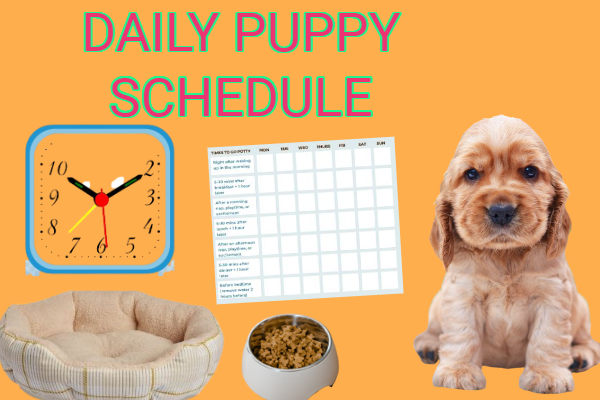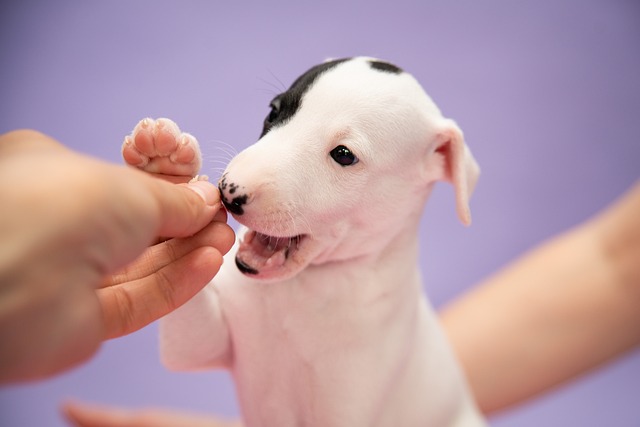This how to housebreak a puppy post may contain affiliate links. Learn more on my Affiliate Disclosure page.
How to housebreak a puppy can be a challenge that many pet owners face is the dreaded task of housebreaking their puppy.
From sudden accidents on the living room carpet to mysterious puddles in unexpected places, it's easy to feel overwhelmed and frustrated.
However, fear not! With patience, consistency, and a little guidance, you can successfully teach your pup proper bathroom etiquette and transform them into a well-behaved household member.
This article will explore effective strategies and practical tips on quickly housebreaking a puppy – ensuring harmony between you and your four-legged companion.
How To Housebreak A Puppy
Understanding the needs and behavior of a puppy is crucial when it comes to housebreaking them. Like human babies, puppies also learn the world's ways and require their owners' patience, consistency, and understanding.
One crucial aspect is that puppies have tiny bladders and can only hold their urine briefly. Therefore, taking them outside frequently throughout the day is vital to relieve themselves.
Additionally, knowing how puppies communicate through body language can go a long way in housebreaking them effectively.
Puppies often display sure signs when they need to eliminate, such as pacing, sniffing the ground excessively, or circling an area repeatedly. By observing these cues, you can anticipate when your puppy needs to go outside, which allows you to prevent accidents in the house.
Furthermore, establishing a routine is vital for rearing a well-behaved puppy. Just like children thrive on structure and predictability, dogs also benefit significantly from having a consistent schedule for meals, playtime, walks, and bathroom breaks.
Keeping things consistent helps with their overall behavior but also aids in potty training by setting clear expectations for your furry friend.
How to housebreak a puppy depends on you taking the time to understand your puppy's specific needs and behavior patterns.
By implementing effective potty training techniques outlined in this article, you'll be well on your way towards having a happy and obedient companion who knows exactly where to do their business—outside!
Establishing A Consistent Potty Routine
Establishing a consistent potty routine is one of the most crucial aspects of housebreaking a puppy. It helps instill good habits and fosters a sense of security and predictability for your furry friend.
To achieve this, you must set up a schedule that aligns with your pup's natural body clock and stick to it religiously.
Establishing a firm potty routine is essential when teaching your precious puppy how to do their business in the right place. Be sure to bring your canine companion to the designated potty area at specific times each day, such as immediately following meals, naps, or play sessions.

Consistency is vital regarding how to housebreak a puppy by establishing a potty routine. Take your puppy to the designated potty area at the exact times every day, such as after meals, naps, or play sessions.
Praise and reward them when they potty in the right spot, reinforcing positive behavior.
Additionally, observe their behavior for signs like sniffing or circling, as these are cues that they may need to use the bathroom. By paying attention and following through with consistency, you can ensure that your puppy becomes accustomed to an established routine quickly.
Remember that accidents are bound to happen during the housebreaking process – it's all part of the learning curve for you and your pup. However, don't get discouraged if setbacks occur occasionally.
Consistently implementing a potty routine will help solidify your puppy's good habits over time. Stay patient, persevere through challenges, and celebrate every accomplishment – your efforts will pay off in fostering a happy and well-housetrained pup!
How To Housebreak A Puppy With Positive Reinforcement
Using the positive reinforcement training strategy makes it easy for anyone to learn how to housebreak a puppy. Instead of punishing your furry friend for accidents, reward them for going to the right place.

Using positive reinforcement techniques can create a more positive and enjoyable experience for you and your pup.
One effective method is to use treats as rewards. Every time your puppy goes potty outside or on a designated puppy pad, praise them enthusiastically and offer a small, tasty treat.
A reward will give them an immediate incentive to repeat the behavior in the future. Additionally, consider using verbal cues such as going potty or doing your business while they are relieving themselves–over time.
They will associate these phrases with the act of going potty.
Another powerful tool for housebreaking is creating a consistent routine. Dogs thrive on structure by knowing what you want them to do. Establishing regular feeding times helps regulate their bowel movements, making it easier to predict when they need to go out.
When taking them outside or leading them to their designated area indoors, be patient and let them explore before giving clear signals that it's time to eliminate.
By utilizing positive reinforcement techniques like treats and creating a consistent routine, you can shape your puppy's behavior while strengthening your bond with each other.
Remember that patience is critical during this process; accidents are bound to happen along the way but remain calm and avoid scolding or punishment.
How To Deal Calmly With Accidents
How to housebreak a puppy requires you to handle accidents when they occur. It can be frustrating and overwhelming, but staying calm when approaching the situation is essential.
First and foremost, resist the urge to scold or punish your puppy for making a mess. Scolding will only confuse them and make them afraid to go potty before you.
Instead, focus on redirecting their behavior to the appropriate spot. When you notice your puppy about to have an accident, gently pick them up and take them outside or to their designated potty area.
Be patient with them while they finish their business and offer plenty of praise and rewards afterward.
Another helpful tip is to establish a consistent routine. Puppies thrive on structure, so having set times for meals, playtime, and bathroom breaks can significantly reduce accidents.
Take your furry friend out frequently – ideally every 1-2 hours – especially after naps, meals, or vigorous play sessions.
Remember that accidents are just part of the learning process for puppies and their owners. By remaining calm, redirecting behavior, establishing routines, and offering positive reinforcement, you'll help your puppy become housebroken with patience and effectiveness in no time.
Clean Up Urine or Feces Stains and Odors
How to housebreak a puppy requires you to purchase quality enzyme cleaners to tackle urine or feces stains and odors effectively.
Start the clean-up by using paper towels or a clean cloth. Remove as much urine or feces as possible with paper towels or a clean cloth.
Avoid rubbing or smearing the mess, as this can spread it further.
Enzyme cleaners contain will break down the organic compounds in urine and feces, eliminating the visible stains and unpleasant smells.
It would be best if you eliminated any lingering odors that may attract your puppy back to the area is essential.
Using an enzyme spray cleaner, remove any excess waste material using disposable gloves or paper towels. Once you have removed as much as possible, spray generously the affected area with the enzyme cleaner, ensuring it is soaked thoroughly.
Suppose you do not have an enzyme spray cleaner available.
All you need is a trusty spray bottle and some white vinegar. Mix it with equal water. Now, you have a homemade cleaning solution that works like the enzyme spray cleaner.
Puppy Crate Training Tips
New puppy owners must often learn how to housebreak a puppy using crate training. Many people see crating as a form of punishment or confinement, but in reality, it is more like giving your puppy a cozy den of their own.
Using the crate consistently and positively creates a safe space for your pup and teaches them bladder control.
One of the critical benefits of crate training is that it helps establish a routine for your puppy. Dogs are naturally den animals and instinctually avoid soiling their sleeping area.
By keeping your puppy in the crate when they are likely to need to pee or poop (such as after eating or waking up), you are setting them up for success. With time, they will learn to associate being in the crate with their bladder until you let them outside.
Another advantage of crate training is that it helps prevent destructive behavior when you can't supervise your pup. Puppies have boundless energy and curiosity, often leading to mischief when left unsupervised.
Instead of leaving them loose in the house where they could chew furniture or get into dangerous situations, providing them with a securely locked crate ensures their safety while protecting your belongings.
Gradually Increase Your Puppy's Freedom And Independence
Crate training is an excellent way to gradually increase your puppy's freedom and independence while keeping them safe and out of trouble.
Start by introducing the crate as a positive and comfortable space for your furry friend. Let them explore it at their own pace, with the door open, and reward them for going inside voluntarily.
Once they are used to spending short periods in the crate, you can begin to close the door for longer durations.
Remember that when crate training, it's crucial not to rush the process. Gradually increasing the time your pup spends in the crate will help prevent any feelings of anxiety or confinement.
Begin by leaving them crated for just a few minutes while you remain nearby. Slowly extend this time as they become more comfortable, providing plenty of toys and treats to entertain them.
By patiently building up their independence in this controlled environment, you'll set a solid foundation for housebreaking success.
As your puppy gets accustomed to more extended periods in their crate without distress, you can start allowing supervised moments of freedom outside the crate within a confined area such as a playpen or baby-gated room.
Space outside the crate allows your pup to explore on their terms while ensuring they're still under close supervision.
Gradually increasing these moments of unsupervised but contained freedom will build trust between you and your furry companion while reinforcing good behavior patterns. Always ensure appropriate toys are available during these times so they have something safe and engaging to focus on.
Crate Training Puppy First Night
Once you bring home your adorable new furry friend, crate training becomes essential to setting boundaries and providing a safe space for your puppy.
However, the first night in a crate can be challenging for you and your pet. It's normal for puppies to feel anxious or scared in unfamiliar surroundings. But crate training on the first night can become a positive experience with patience and proper techniques.
One key strategy is to make the crate appealing and comfortable for your puppy. Line it with soft bedding, such as blankets or towels, that have your scent on them to provide familiarity and reassurance.
Consider placing a treat or toy inside the crate to entice your pup to enter willingly. By making their new den cozy and inviting, you'll help ease their anxiety and encourage them to view the crate as a haven rather than a cage.
Another important aspect of getting through the first night is establishing trust with your puppy. They are still adapting to their new environment, so patience and understanding are crucial.
Resist the urge to give in if they whine or bark during bedtime – this will only reinforce attention-seeking behavior. Instead, try using techniques like gradually increasing crating time during daytime naps or using positive reinforcement when they remain calm in the crate.
The first night in a crate may present challenges as your puppy adjusts to their new surroundings.
K9 Training Institute Free Workshop
The K9 Training Institute offers a free workshop where you can learn firsthand their effective training methods.
The Free Workshop emphasizes building a solid bond between you and your pup. They explain how to apply positive reinforcement techniques that make learning enjoyable for dogs and their owners.
Does your dog tug on its leash, bark constantly, and won't come when called? Sign Up and get the FREE Obedience Training Workshop Now!
Conclusion For How To Housebreak A Puppy
Celebrating the successful how to housebreak a puppy is a moment worth cherishing. It marks the beginning of a beautiful chapter in your life where you can enjoy each other's company without worrying about accidents or messes.
Take a moment to acknowledge the hard work and effort you've put into this process - it hasn't been easy, but it pays off.
Now that your puppy is well-behaved indoors, it's time to focus on strengthening that bond between you two. Go ahead and plan some fun activities that both of you can enjoy together.
Enjoyable activities could be as simple as a game of fetch in the backyard or long walks in the park. Whatever it may be, remember to celebrate your puppy's success and the journey you've had together so far.
Having a well-behaved puppy opens up new possibilities for adventures and experiences. Take this opportunity to explore different places together – hiking trails, pet-friendly beaches, or dog parks in your community.
These outings provide mental stimulation and exercise for your furry friend, but they will also create lasting memories for both of you.
So grab that leash, pack some treats, and embark on exciting new journeys with your four-legged companion – after all, there's no better way to celebrate success than by enjoying life together!






